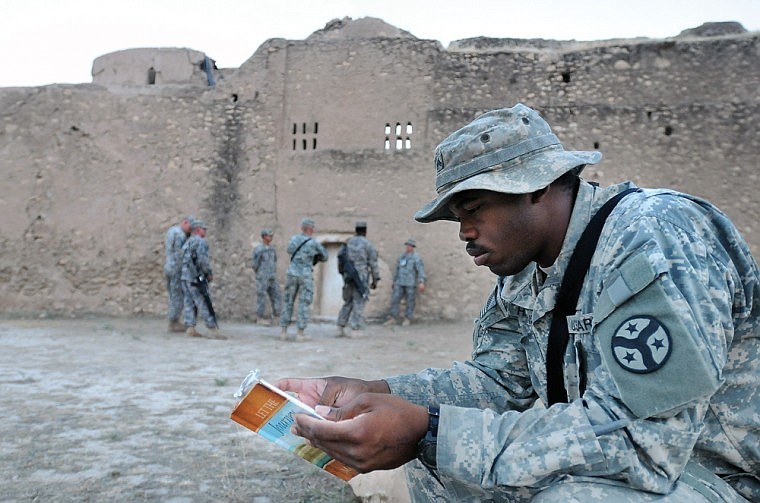Kalispell native gets tour of Iraq monastery
CONTINGENCY OPERATING BASE MAREZ, Iraq — Kalispell native Matthew Christensen and old friend Brandt Klawitter, both Army chaplains, never imagined that one day they would walk within the deteriorating walls of a possible archeological cache and pray at its altar.
The abandoned sixth-century St. Elijah’s Monastery of Ninawa province, Iraq, once a center for the regional Christian community, served the Army chaplain community on June 11. The event brought the two old friends back together in study and prayer.
Christensen is a chaplain with the 2nd General Support Aviation Battalion, 1st Aviation Regiment and Klawitter a first lieutenant with the 14th Transportation Battalion, 13th Sustainment Command (Expeditionary) and a Hermann, Mo., native. The two had studied biblical archeology together seven years before meeting at the monastery.
Their recent encounter happened by chance.
As Klawitter scanned his ID card at the entrance to the dining facility at Contingency Operating Base Diamondback, Iraq, one morning, he looked up to see his old friend, Christensen, wandering around looking for coffee.
The two had no idea the other was visiting troops on the base at the same time. Klawitter’s office of operations is at Joint Base Balad, Iraq, and Christensen’s at Contingency Operating Base Taji, Iraq.
Klawitter and Christensen met during postgraduate work in 2001 at Concordia University in Seward, Neb. They had Greek and Hebrew classes together and continued studies at Concordia Seminary in St. Louis.
They also started Chaplain Basic Officer Leadership Course together.
“We were friends so we signed up for the same summer,” Klawitter said. “We rode down together in his minivan to Fort Jackson, S.C. I baby-sat his kids before. His family came out to my family’s house. He helped my dad and I put in a rail fence.”
Klawitter described Christensen, who was previously a diesel mechanic in the Army, as accomplished and squared-away.
“He grew up in the mountains of Montana,” Klawitter said. “His dad runs mules and horses up at Glacier National Park.”
Christensen described Klawitter as both a people person and an intellectual.
“If you have any kind of issue, he’s one of the guys you could call at any time,” Christensen said.
Klawitter said it is a real blessing to have a good friend in Iraq.
“He’s one of those friends you trust in, you depend on, you’ve been through different life experiences with,” Klawitter said. “I give him a call every once in a while just to say ‘Hi.’ When we get together, we compare notes about what’s worked and what’s not.”
Of course, this time around the chaplains did more than just catch up; they visited an at least 1,500-year-old building together, the oldest standing Assyrian monastery in Iraq.
Geoffrey Whitaker, first lieutenant garrison chaplain for Regimental Fires Squadron, 278th Armored Cavalry Regiment, 13th Sustainment Command (Expeditionary) and a Murphy, N.C., native, leads weekly St. Elijah’s monastery tours.
He put together a VIP tour for Klawitter, Christensen and their chaplain assistants.
“The tours boost interest in spirituality,” Whitaker said.
Whitaker has been working to build interest in stabilizing the monastery to preserve the building and the Christian heritage it holds. St. Elijah’s has been placed on an Iraqi government list of sites to be preserved.
“The Iraqi facilities engineering team is working on a full-blown plan with diagrams, a timeline and cost of materials,” Whitaker said.
Whitaker said the monastery is Iraqi history. As such, the Iraqis should lead the process of preservation, with Americans only helping.
“In this day and age you don’t think of Iraq as having much to do with Christianity,” Klawitter said, “but there actually is a history over here, just like in Turkey there is a ton of Christian history.”
Klawitter said St. Elijah’s was something adventurous to check out.
“A lot of soldiers now don’t go outside the wire and see much of the Iraqi culture and history,” he said. “To see something of cultural value, of religious significance, it reminds you of another side of this land that doesn’t have to do with the present war.”
Klawitter and Christensen said during the visit they felt tied historically to the Christians who came before them to the monastery.
They said they thought back to their biblical archaeology class and wondered what they might dig up if they actually had the chance to excavate.






